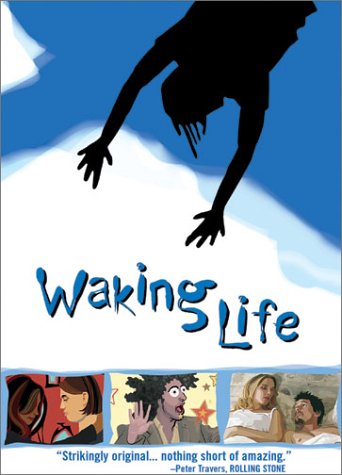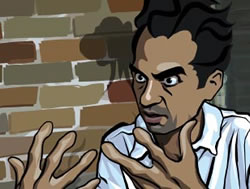Now, "Bangor Rep" has an eclectic taste - from his love of MUSE to his obsession of Spiderman
to his obsession of Spiderman , he sure is a strange creature. One thing which he loves, are films that are deemed so important they reach a special place in your heart. They get you so involved its almost spiritual - akin to an incredible song. For a long time, Bangor Rep - aka, Graham - recommended to me 'Waking Life'
, he sure is a strange creature. One thing which he loves, are films that are deemed so important they reach a special place in your heart. They get you so involved its almost spiritual - akin to an incredible song. For a long time, Bangor Rep - aka, Graham - recommended to me 'Waking Life' and, I won't lie - its a weird one. But I can see his attraction to the film. The focus is lucid dreams - those dreams that when you dream them, you can control them. You walk around in them and you are thinking, in the dream, "wow, I'm in a dream ... I can do whatever I want...". These dreams can often become wet dreams. But thats a different story altogether.
and, I won't lie - its a weird one. But I can see his attraction to the film. The focus is lucid dreams - those dreams that when you dream them, you can control them. You walk around in them and you are thinking, in the dream, "wow, I'm in a dream ... I can do whatever I want...". These dreams can often become wet dreams. But thats a different story altogether.
Anyway, I watched this film one morning in the hope of understanding this eclectic taste and some intersting insights came to mind.
Having watched 'Coffee and Cigarettes' many years ago, this film seemed to have a similar - can I say narrative? - thread to that. Multiple conversations between characters. I am sure this dates back to Greek philosophy whereby metaphorical characters play out roles and situations to make a point or to explore and issue. Off the top of my head, Plato's Allegory of the Cave
many years ago, this film seemed to have a similar - can I say narrative? - thread to that. Multiple conversations between characters. I am sure this dates back to Greek philosophy whereby metaphorical characters play out roles and situations to make a point or to explore and issue. Off the top of my head, Plato's Allegory of the Cave is a fictional world that uses characters to represent a way of thinking - rather than simply explaining "everything is fake", he uses a situation to make his point. In a similar way, I assume Linklater and Jarmusch do the same things. Only recently, Jim Jarmusch released 'Limits of Control'
is a fictional world that uses characters to represent a way of thinking - rather than simply explaining "everything is fake", he uses a situation to make his point. In a similar way, I assume Linklater and Jarmusch do the same things. Only recently, Jim Jarmusch released 'Limits of Control' and, again - though in a different context (assassin on the hunt...) - this involved many conversations between characters. Though I haven't seen the film, many critics seemed to make the pint that Jarmusch was losing his touch by using this technique. One thing that is interesting is how Linklater chose to use Julie Deply and Ethan Hawke from his the 'Before Sunrise'
and, again - though in a different context (assassin on the hunt...) - this involved many conversations between characters. Though I haven't seen the film, many critics seemed to make the pint that Jarmusch was losing his touch by using this technique. One thing that is interesting is how Linklater chose to use Julie Deply and Ethan Hawke from his the 'Before Sunrise' /'Before Sunset'
/'Before Sunset' diptych. I would assume a practical choice - and something that would assist the marketing of the film - but this self-referential style again mimics a very artistic style. The film is not only a work or art - it is a work of art Linklater feels is very important. To stress the issue moreso - Linklater appears himself alongside Soderbergh and others...
diptych. I would assume a practical choice - and something that would assist the marketing of the film - but this self-referential style again mimics a very artistic style. The film is not only a work or art - it is a work of art Linklater feels is very important. To stress the issue moreso - Linklater appears himself alongside Soderbergh and others...
Linklater, in a god-like position (well, he is the director...) states the claim that lucid dreaming could be 'tastes' of the afterlife. A little hint of what is waiting. Is this his personal opinion or is he 'playing the role of God' considering his position in the making of the film? Again, we get wrapped into this dream. The dream is confusing, the film is all over the place - jumping from fiction to what could be fact. But this merely makes the film more involving. You are not watching mainstream cinema - this is film as art.
The soundtrack raises more parrallels. The use of strings give the film an element of Hitchcock - as Bernard Herrmans strings screech out to make the surrealist film even more relevant. Obviously, 'Vertigo' would be the first port of call - a film that could effectively be a dream within a dream. Dare I say it - a lucid dream. Then, on another level we have Salvador Dali - the popular surrealist artist. Perhaps, linking Hitchcock to Dali, 'Spellbound'
would be the first port of call - a film that could effectively be a dream within a dream. Dare I say it - a lucid dream. Then, on another level we have Salvador Dali - the popular surrealist artist. Perhaps, linking Hitchcock to Dali, 'Spellbound' is the real inspiration. Suffice to say, I have not seen 'Spellbound' so hesitate to make a parrallel.
is the real inspiration. Suffice to say, I have not seen 'Spellbound' so hesitate to make a parrallel.
Animation for Adults
The artistic style that is used in 'Waking Life' preceeds 'A Scanner Darkly'
How do you show the fluidity of movement between rooms - a fluidity that, in a dream remains normal, but when you think back you can't understand how such a movement could happen.
I shall close this brief overview here. This is an experiment. Using fascinating themes and discussion topics to keep you interested, but ultimately an experiement. The maxim "Sanity is a madness put to good uses; waking life is a dream controlled." is where the title comes from and it is Linklaters masterful direction that makes the viewer stick with it. Its interesting reading synopsis' for the film, as I feel this narrative is merely what binds everything together. It is, as Roger Ebert described the film "a cold shower of bracing, clarifying ideas" - but ideas without a character you root for or a narrative you expect an ending from. That is a unique type of film to enjoy and I am unsure whether I did enjoy it. But maybe that is merely my dreamlike confusion upon finishing the film...



Someone else saw Waking Life... Cool. I didn't terribly care for it. Some of the conversations stand up pretty well on their own, but most of them are pretty mediocre. While I give Linklater props for being daring and making something unique, it's not something I would care to watch again.
ReplyDeleteOn Rotoscope:
ReplyDeleteLinklater's use of rotoscope gives the Platonic style of narrative an intrinsic interest. Waking Life is definitely a philosophical treatise for the new millennium. With the ability to show two people in conversation more interestingly than Plato's written word and Jarmusch's C&C -- now we can absorb the language and concepts while watching technology and art meld in a dialectic synthesis.
I love that tech and art are finally intermingling with so much more success than ever before. Waking Life was, as I remember it, the first indie movie to take advantage of that (beyond the tech that is filmmaking of course, and the DV revolution which Linklater helped to usher in anyway).
I've always heard that this is an awesome movie. Seems totally out there, but I dig that. Will definitely be checking it out. Good review, man.
ReplyDeletenice! of course, i love the movie and i'm glad you make some interesting points here! i particularly like the point you make about people trying to give a synopsis lol, that always baffles me! "a boy finds himself wandering through a.." it just doesnt make sense!
ReplyDeleteanywho, it does have its flaws- when watching it a few times i find the pacing/consistency is difficult at times. like, when you dont find a certain interaction as interesting and you almost want to go back to others and hear more from them! but i guess the scenes are occasionally so separated they act almost like tracks on an album, and in that it does still strike me as truly fascinating... i think that's all i can find to say on the matter for now. :D good review!
oh, ps- that was 'Bangor Rep' :)
ReplyDelete@Alfindeol - I'm with you really. Unless lucid dreams is your thing, I don't care to watch it again and again.
ReplyDelete@Red Couch - Maybe the use of rotascoping is what makes it 'important' to watch ... when, reality is, sicne then its been done better and used in better stories...
@Aiden R. - its worth checking out. Its only a short film but surreal and an interesting talking point post-viewing. i wouldn't buy it though.
@Bangor Rep - I like your 'album tracks' analogy. Maybe it would work well in this ipod-culture whereby you can select sections you like and ignore the ones you don't like...